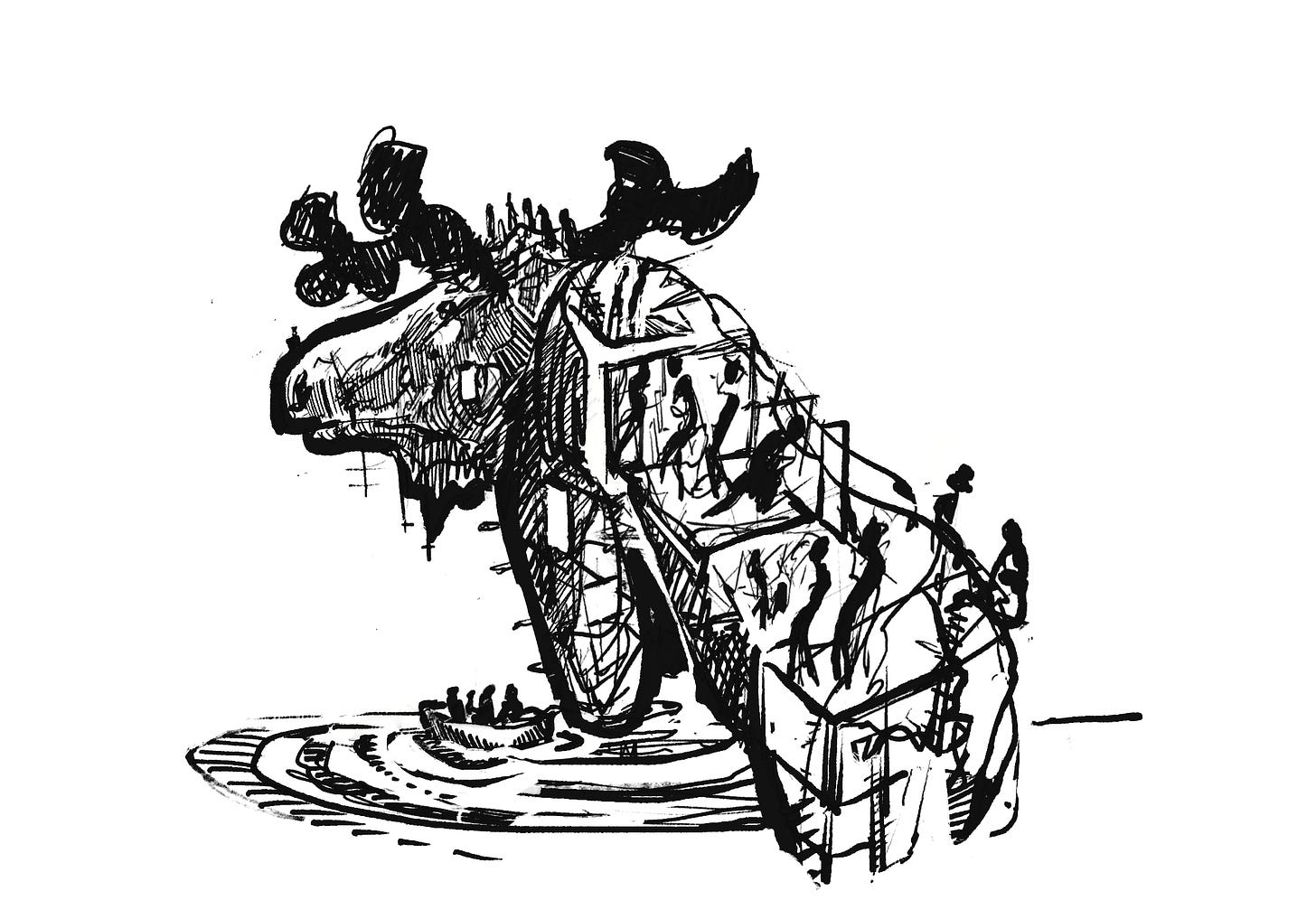In May 1969, I was among a crowd of some 4000 people pushing back against a police line that was protecting the University of California’s demolition of People’s Park in Berkeley, California. In that confrontation, James Rector (a bystander) was shot and killed by the police. About 130 others were admitted to hospitals for shotgun wounds, head trauma, and other police inflicted injuries. Police don’t resort to use of live ammunition to control street protests unless someone high up makes this call.
Two weeks later, I was in a panel truck headed to the Olympic Peninsula in Washington State to live in a commune.
This sequence of events mirrored that of many activists in that era. From the early 1960s on, there was an intensifying struggle to change the foundations of the American social, economic and political system that had embroiled us in the Indo-China War, tolerated institutionalized racism, exploited Chicano farm laborers, marginalized native peoples, held back women, fostered economic imperialism, and ravaged the environment.
A diversity of movements arose to challenge this system. As events progressed, it was recognized more and more that the struggle for changes of policy were insufficient, that the need was (and is) for systemic change to a life-centered society.
As the seriousness of the people’s challenges to established American institutions grew, the oppressiveness of the State’s response intensified. In addition to the use of lethal police force in Berkeley in 1969, there was the 1968 Chicago Democratic Convention police riot, the police response to the 1967 Watts Rebellion (34 killed), and the Kent State massacre in 1970.
For many of us, continued political activism became a dead end. The torrent of political rebellion began to dissipate.
However, aspirations for progressive social change didn’t die; they took a new direction. Many activists came to recognize that political change couldn’t progress without changes in culture and in institutions, and that changes in these spheres needed to take a leading role in the building of a new, life-centered society. In response to this awareness, many took up the path called for by the Wobblies in an earlier era to “Build the new society in the shell of the old.”
Thus, there came to be an historic confluence of factors that led to a bifurcation in the focus of the struggles for liberation, with the political actionaries continuing on one path and the cultural solutionaries another.
My path came to be with the solutionaries as I pivoted from the battle for People’s Park to living in a rural commune, in which the tools, practices and ideas featured in the Whole Earth Catalog now came to be of greater relevance than political change strategies.
Emergence of a Life-Centered Society
Since the late 1960s, the emergence of a green, regenerative, life-centered society has occurred in stages. Each stage has been catalyzed by a conceptual development that brought forward a more integrated level of expression. The overview which follows offers a very simplified account of these stages of evolution.
First Wave
In the 1970s, efforts to build models of new social institutions, first begun in the late 60s, intensified. These new social institutions gave practical expression to new values, and their rise was the First Wave in the evolution of a new, life-centered culture.
Some expressions of First Wave practices include cooperative enterprise, small-scale organic farming, alternative media, intentional communities, simple living, traditional home crafts, appropriate technology, and holistic medicine. None of these were new developments. Consumer cooperatives date to the Rochdale Pioneers in 1844; communal living was found in the utopian communities of the late 1800s; organic farming was started by Albert Howard in England in the 1930s and the Rodale Institute in America in the 1940s, and simple living was central to Shaker culture. But in the 1970s these visionary innovations arose anew as part of the surging aspirations of idealistic youth who sought to build the new society in the shell of the old.
These First Wave endeavors were grassroots and small-scale. The values they expressed included democratizing enterprise, functioning collectively, valuing the small scale, and returning to natural ways of growing, healing, and living.
In summary, the First Wave is characterized by:
small-scale alternative institutions
adoption of historic models
participatory, grassroots networks
synthesized into green counterculture
And prominent values of the First Wave are:
democratizing enterprise
functioning collectively
valuing the small scale
returning to natural ways of growing, healing, and living
Second Wave
The Second Wave emerged around the early to mid 1980s. It was informed by the growing concern with sustainability and by new philosophical and scientific outlooks that emphasized whole systems over reductionism. And, by this time, the accumulated experiences building a green culture had created the potential for more ambitious and integrated undertakings.
Prominent expressions of the Second Wave include ecovillages, permaculture, and bioregionalism. Influential concepts include regenerative design, integrated expressions of sustainable living (such as co-housing and ecovillages) and envisioning social life in the context of bioregions.
As an example of the integrative vision of a Second Wave undertaking, here’s the definition of an ecovillage:
“An intentional or traditional community using participatory processes to holistically integrate ecological, economic, social and cultural dimensions of sustainability to regenerate social and natural environments.”
Participants in the Second Wave still self-identified as belonging to a counter-culture, but this identification softened as participation in Second Wave initiatives broadened, moving into more traditional cultural spaces and into non-Western settings. And some Second Wave movements spread to the developing world (e.g. permaculture) or found resonance with non-Western traditional cultures (e.g. ecovillages).
Third Wave
The beginnings of a Third Wave appeared in the early 2000s. Its characteristic concerns have been with creating sustainable, decentralized, cooperative, integrated development at a community level. The central aspiration animating the Third Wave is to create local societies that are sustainable and locally empowering.
Perhaps the most prominent initiative that reflects a Third Wave approach is the Transition Movement which, at its peak, had a presence in over one thousand communities. Other significant expressions are economic re-localization initiatives, and the solidarity economy movement (with Cooperation Jackson being the most developed example).
In this phase, there’s often recognition that the relevant social divide is not between liberals and conservatives but between centralists and decentralists, and between elites and the common people. The feeling of common cause in building a new society becomes less defined around green, counter-culture values and more around a sense of humanity’s common predicament — we all face climate change, dwindling resources, loss of local empowerment, degraded ecosystems, economic globalization, peak oil, etc.
Third Wave initiatives often seek to integrate the diverse sectors of a community. Both the Willits Economic Localization (WELL) project in California and the Port Townsend Local 20-20 movement in Washington organize themselves into sector defined groups — i.e. food, transportation, health care, energy, etc. — then bring these sector-based groups together to develop synthetic community approaches for achieving sustainability and resilience.
The mission statement of Port Townsend Local 20/20 captures the spirit of community transformation of Third Wave endeavors:
“Working together to foster a regenerative, sustainable, resilient, equitable, and inclusive community in Jefferson County through both action and education.”
So, Third Wave initiatives can be characterized by:
scaling up to a community level
being inclusive beyond a green counterculture demographic
planning and preparing for resilience
Integrating essential social sectors into a unified movement
Impediments to the Third Wave
The makings of a Third Wave have been apparent for a couple of decades. However, this wave has gained little traction. (At present, only 32 of the 162 Transition groups in America are listed as being active; the actual number is likely much less.)
Taking up the task of building a life-centered society is characteristically different from establishing a cooperative, an ecovillage, or a permaculture food forest. In my view, Third Wave initiatives are limited in two critical respects.
Socio-Economic Theory. First, there is not yet a socioeconomic theory and practice of decentralized development, one that can guide integrated development schemes within an overall developmental framework.
Charles Paprocki, in a paper entitled “Principles and Guidelines for Designing a Grassroots Life-Centered Economy,” laid down a critique permaculture that speaks to the limitations of the Third Wave:
“Permaculturists who are working to meet the basic needs of local people have not developed a post-capitalist socio-economic paradigm of their own. Unless there is a clear [socio-economic theory], the movement is doomed to offer little more than backyard hobbyists.
“We must have a socio-economic theory and strategy to guide our project work. We need principles that allow us to scale up our projects to benefit the community as a whole. Without such a socio-economic vision, we will not be able to create sustainable basic needs economies in which local people can participate and benefit.”
Social Movements. Second, when working at the community level, there are established financial and political interests to contend with. In the Third Wave, the movement “to build the new society in the shell of the old” can no longer find niches in the dominant society to grow; it now comes up against the cultural, economic and political dominance of the old.
In response, social movements will be required to mobilize the political power to press grassroots demands for a life-centered society. This is to say, there will be a need to fuse the efforts of political actionaries with those of the cultural solutionaries. Actionaries and solutionaries must become one.
And what is the fundamental demand that social movements should be advancing? It is to return economic empowerment to people and communities. For this, social movements should demand economic democracy and economic decentralization.
Beyond the Third Wave
In the effort to engage and transform the workings of whole communities, Third Wave initiatives take building a life-centered society to a new level. But transforming communities is not the culmination of what is required, as humanity’s core problems are global in nature.
However, as the polycrisis deepens, much of the struggle for systems change will take place at the local level. This is the main arena in which transformative dynamics will play out.





I got rounded up in that police line, too. I was sitting at a bus stop on my way home from my job in San Francisco. I talked a police officer into letting me go. A few years later I "dropped out" into the backwoods of Idaho with a small group of other people, among them, JD Smith, co-founder and contributor to the Whole Earth Catalog. No electricity, no plumbing, an outhouse out back, no bills, no phones. It was a transformative experience. I discovered that deep quietness, direct connection to and dependence on nature, and soaking in the natural hot spring looking up at the stars at night were the REAL luxuries of life.
It would be important, I think, to develop a working model, video, story, etc. that integrates the principles, procedures, guidelines, governance and practicalities of putting this into action. How to's, like where to begin, necessary elements to forming a community, processes, stages. For instance, how to get through the first several years of becoming a self-sustaining community. What is the level of commitment per person? How would we provide the basics; food, shelter, health services, emergency help, etc.? Perhaps designating an area for a community green garden, creating a sense of community around that, sharing knowledge/expertise and resources, training, organizing volunteers, and growing from there, I would imagine. Having never experienced a commune or eco village, so I would not know how or where to begin.